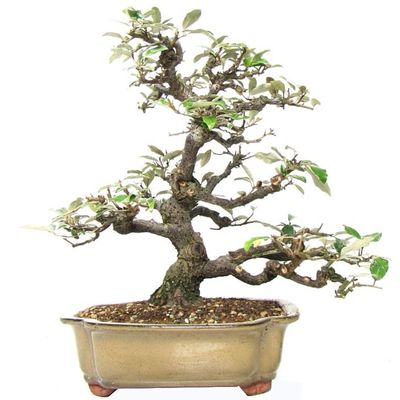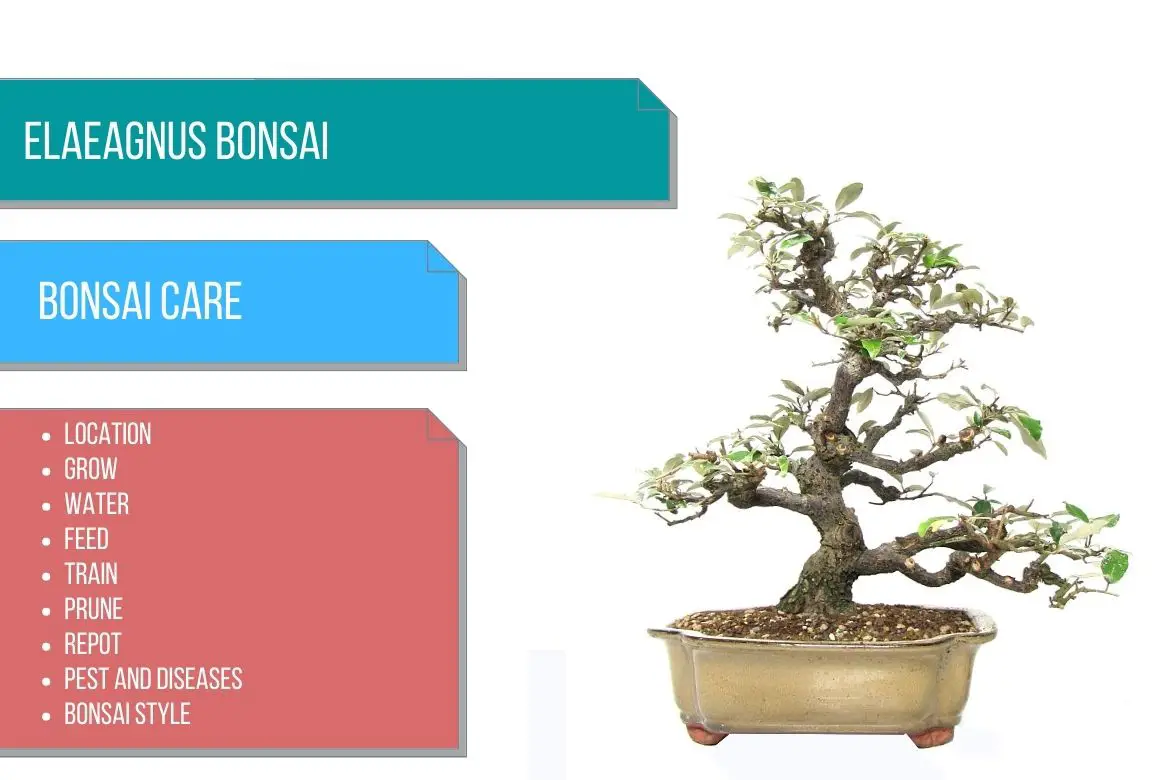
Elaeagnus / Oleaster / Silverberry
(Elaeagnus)
Country of Origin : China, Japan
Bonsai Styles : Informal upright, slanting, semi-cascade, cascade, root over-rock, twin-trunk, clump
Zone : 4 – 8
Elaeagnus is a small tree or shrub, sometimes thorny, with a strong root system that allows it to survive in harsh environments. (eg. poor soil, high wind etc)
Elaeagnus plants are generally fast growing.
The plant has simple, tough-textured, alternating stalked leaves that can be evergreen or deciduous (depending on the variety), bright green or silvery above, paler beneath, with tiny silver or brown hairs.
The axillary fragrant flowers may be single or grouped in clusters, and the edible fruits (achenes) have a fleshy perianth that is red, orange-yellow or golden in color. These fruits persist until the following year. Remember that not all the fruits of this genus are edible.
There are numerous species of Elaeagnus (more than 60). However, some of the Elaeagnus varieties that are commonly used to grow bonsai are:
- Elaeagnus multiflora (goumi): This is a deciduous shrub. It produces flowers in the spring. Leaves are green above and silver on the underside.
- Elaeagnus pungens (silverthorn): This is a thorny evergreen shrub. It produces flowers in the autumn. Leaves have shiny green upper surfaces and prominent brown speckles on the white undersides. This species has also been used to make several other cultivators.
- Elaeagnus umbellata (Autumn olive): This is a deciduous shrub. It produces flowers in the spring. Foliage is dark green above, silvery underneath.
Besides being a flowering bonsai tree, Elaeagnus bonsai also makes an attractive fruiting bonsai specimen. They are suitable for the informal upright bonsai style.
You will see some Elaeagnus species in local nurseries sold as garden plants. Make sure that you buy the right species as not all Elaeagnus cultivars are suitable for growing a bonsai.
Read more about other bonsai trees species in : Types of bonsai tree
Best location to keep Elaeagnus bonsai tree
All varieties of Elaeagnus bonsai should be kept in full sunlight throughout the growing season as these trees are suited to being an outdoor bonsai tree.
Keep them in a garden or on a balcony that receives plenty of sunlight.
They can also be kept in partial shade, however Elaeagnus pungens will lose its silvery sheen when place in shade.
These trees originate from northern Asia and are completely hardy in temperate areas. Hence, there is no need to give any special protection in winter.
These are very hardy trees and can tolerate temperatures as low as 32°F (0°C).
Place them in a cool, unheated room during the winter. Protect the trees from frost.
The roots of these trees are very strong. They can tolerate high winds. (It is common for them to be planted as windbreaks and shelterbelts, especially in exposed locations near the coast and areas that are exposed to the elements.)
IMP: Refer to do bonsai trees need sunlight for more indoor and outdoor bonsai location ideas. Also, refer sunlight requirements for indoor plants for more indoor gardening ideas.
Propagation of Elaeagnus bonsai tree
Elaeagnus can be propagated by sowing seeds, cuttings or root suckers.
Take semi-hard wood cuttings in late summer. Root suckers can be taken in spring.
Watering Elaeagnus bonsai tree
During the growing season, water regularly and allow the soil surface to dry slightly before watering again, but do not let the rootball completely dry out.
Even in winter, these species require relatively frequent watering because of their large leaves. In the event that they are allowed to dry out, they will lose a lot of their foliage. It is possible to use normal tap water.
If you have moved the tree indoors, you can mist the foliage occasionally.
Read watering bonsai tree for more details and also about bonsai water immersion technique.
Wiring Elaeagnus bonsai tree
The primary branches of the tree will need wire training as the new shoots have a tendency to grow upwards.
In midsummer you can wire the new shoots when they have just hardened.
For branches that are one or two years old, wire can be easily used. Older limbs, however, will need to be guyed down.
You can keep the wires on the branches for the entire growing season or for one year.
Read : Detailed guide on How to wire a bonsai. This extensive guide includes all the wiring techniques and Do’s and Dont’s. It will also show you other bonsai training techniques which can be achieved without using wires.
Pruning Elaeagnus bonsai tree
When to prune Elaeagnus bonsai tree?
How to prune Elaeagnus bonsai tree?
The leaves of Elaeagnus are relatively large. Hence, when you make an Elaeagnus bonsai, aim for a minimum height of 16 inches (40 cm).
Initially, the shoots of plants in the Elaeagnus family grow rapidly in length and consist only of leaf buds. In young plants, leaves do not emerge until later. These shoots should be allowed to grow to a certain length before pruning is performed.
After the new shoot has grown to between 15 and 20 cm (6 and 8 inches), cut it back as far as necessary to achieve the desired crown shape, usually between one and three leaves.
Mature bonsa specimens that are already well-developed and have already been trained can be pruned earlier. The growth will be denser and twiggy as a result.
The goal of pruning these shrubs is to keep the internodes short.
Shortening the new shoots as they are developing can be done in the summer after flowering. (at least 3 months after repotting)
Winter is the best time to perform major structural pruning.
Read how to prune a bonsai to know about the right technique of pruning and more about defoliating a bonsai tree.
Repotting Elaeagnus bonsai tree
How to repot Elaeagnus tree?
Elaeagnus bonsai can be repotted every 2 to 3 years in early spring. It depends on how much pot-bound the roots are.
If not replacing the complete soil, at least replace two-thirds of the bonsai soil at the time of repotting.
Use a standard free draining bonsai soil.
You can also use sharp sand, loam, and peat moss (or garden compost) in the ratio of 1:2:1.
Another bonsai soil recipe for Elaeagnus you can use is a mix of Compost, akadama, peat and river sand in the ratio of 5:2:2:1.
Please check out how to repot a bonsai to know everything about repotting and root pruning a bonsai.
Must Read: Bonsai Soil Recipes
Must read : Choosing the right bonsai container
Feeding Elaeagnus bonsai tree
Apply feed every two weeks throughout the growing season. Do not apply feed in fall and winter.
You can apply a high-nitrogen feed in the spring. And switch to a low-nitrogen feed in the summer.
Read more about bonsai fertilizer and its application. This will also give you more details on how to feed flowering bonsai trees.
Diseases and pest of Elaeagnus bonsai tree
Elaeagnus bonsai trees are susceptible to scale insects, mealy bugs and fungal disease coral spot.
Remove insects manually or with a jet of water. In case of severe infestation, apply insecticide or systemic insecticide.
For fungal infection, apply an appropriate fungicide.
Our comprehensive guide: How to identify and treat bonsai pests and diseases is a great resource for you to see all the organic and inorganic remedies you can use.

